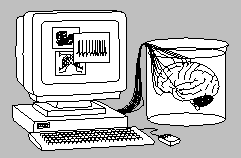Computational models of neurotheology
 When we talk about computational models of neurotheology, what do we mean?
When we talk about computational models of neurotheology, what do we mean?
What first springs to mind is to model an individual brain, or more likely brain/body system, to model the biological processes associated with a religious experience. Modeling transcendance, if you will. But could we tell that in fact what is being simulated is a religious experience? Humans know they are having or had religious experiences by being, at some level, conscious of them. But we can hardly build an entire mechanism of consciousness into our computer model. And even “pure” transcendant religious experiences have historical and social backgrounds, or, to put it another way, occur within the context of certain memories, which even Blue Brain could not model. All in all, a tough problem.
More tractable would be to integrate a coarse statistical model of individual religious experience with a sociological model. In other words, we would model religious experiences, large and small, but at the population level. Some percentage of religious experiences are at the breakthough level that can jumpstart an entire new religion, whereas others might suffice to rejuvenate or sustain a religion, if experienced by enough adherents.
Once a religion has started, we would apply sociological modeling techniques to model its spread and/or decline as the system of doctrines or cermonies that religions inevitably settle into, albeit leavened by periodic awakenings that serve to inject new energy into the religion for some period of time.
The model involves two distinct categories of data. The first relates to the statistical frequency, intensity, and types of human religious experience. I’m not aware of any data on that topic. Our goal would be derive hypotheses for those values, hopefully ones that could be cross-validated, either by working backward through the model from the sociological data mentioned below, or by running multiple scenarios to find one or more that are consistent with the sociological data.
The sociological data I am referring to, which should be relatively easy to capture, is primarily the distribution of sizes of religious groups over time, as well as other peripheral data such as conversion rates.
A flavor of the sociological side of the model can be gained from Simulating the Emergence of New Religious Movements, a paper which crudely models the formation and growth of religions. I can’t agree with the premise that NRM (new religious movement) founders are “rational agents who obtain various social advantages such as reputation enhancement and increased respect from other utility maximizing rational agents who buy their solutions”, but the seeds of one half of the model I propose—the sociological side—are there.
I hereby name this particular approach computational socioneurotheology™.

August 4th, 2006 at 02:25
not paractical